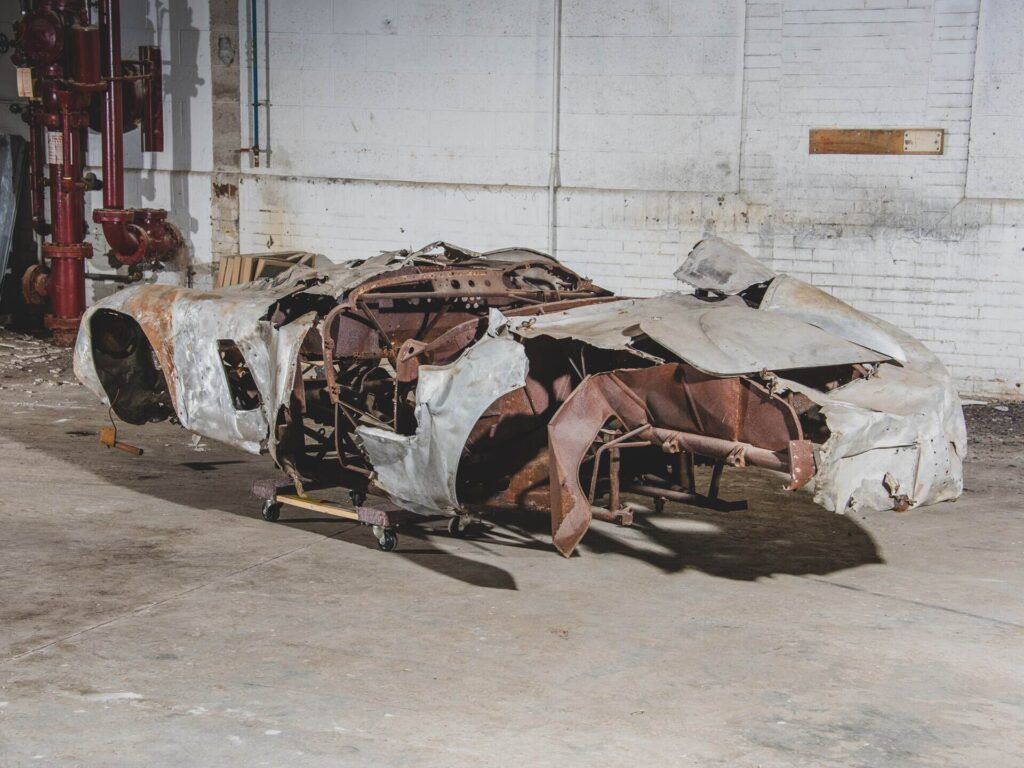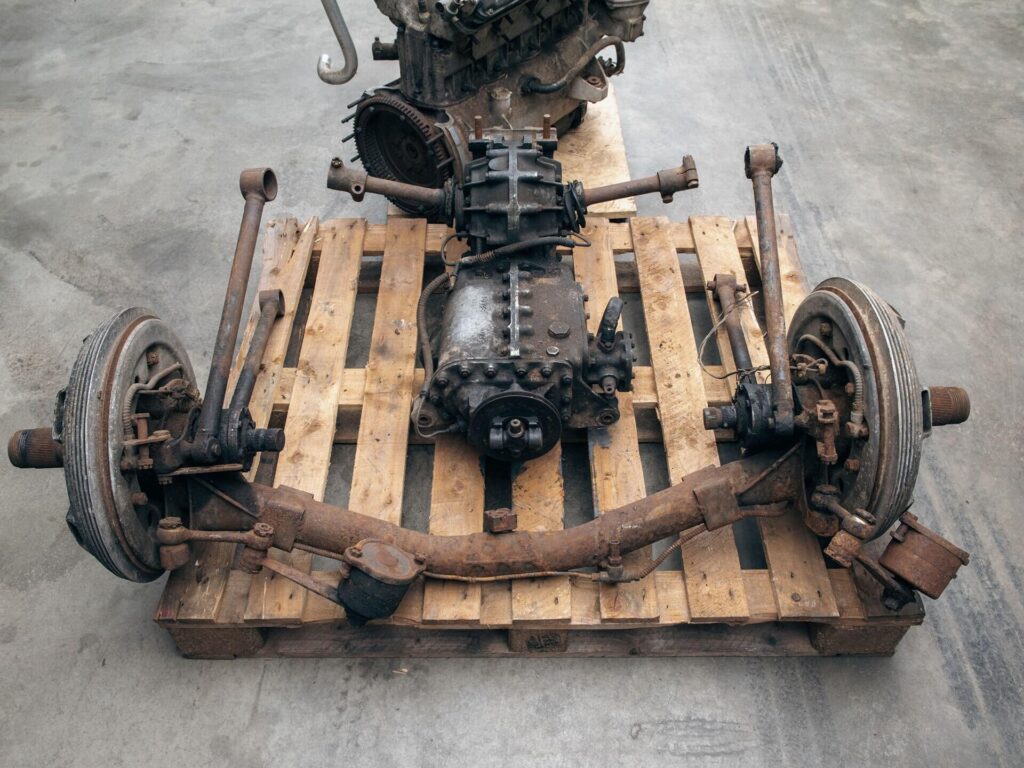Such a headline combined with this photo looks like an unfunny joke, but it’s true: the featured remnant of a Ferrari 500 Mondial has found a buyer for $1,875,000. The result of RM Sotheby’s auction showed all that is absurd about the classic car market. For me, however, it is above all a valuable opportunity to get a glimpse into the thoughts of the professionals involved in such cars.
Author: Mateusz Żuchowski, editor-in-chief of Classicauto
The Monterey auction week I recently announced was indeed the global event of the year for the classic car market. For a few days in one corner of California, classic cars were sold for the equivalent of nearly PLN 1.7 billion. More than 150 of the properties sold achieved a value of more than $1 million. This group included the Ferrari 412 P, whose auction ended with a result of $30,225,000 – making it the fifth most expensive car sold at auction in human history.
However, the most exciting of all the cars present at Monterey was – well, there are no other words to describe it – a bent pile of iron with a few spare parts tossed on a Euro pallet. The very fact of wanting to sell such an “object” to serious people seems audacious, let alone for around $1.2 – $1.6 million – as that is what the star of its auction was valued at by auction house RM Sotheby’s.
Nonetheless, reality has not for the first time surpassed expectations and the presented wreck was not missed by the bidders. Quite the contrary: there was a fierce battle for it, which ended with a result of $1,875,000, a full 17% higher than the upper end of the estimate. By all auction standards, this is a very good result; for the item being sold, it’s an incredible success.
How did this happen? There is a precise answer to this question, and this answer will allow us to understand the mechanisms that drive the contemporary collector car market. In other words: it will allow you to get into the heads of the people – sellers, buyers and their advisers – who deal with this subject professionally and invest substantial millions in it. Join me on this journey.

If it is not the condition that determines the value of a collector car, then what does? As you can see: his background. The Ferrari 500 Mondial is first and foremost a classic Ferrari – a fact that automatically gives it an extremely high value right from the start. It stems from the extremely rich history of victories by the team of the charismatic Enzo Ferrari in the golden age of motorsport, the 1950s and 1960s, when the cars were the most beautiful, the technical thought was the most genuine and the drivers were the most heroic.
In the presented car, all of these features are met (or at least were met). Completed in 1954, the car with serial number 0406/MD was the second of only thirteen of the 500 Mondial with Pininfarina bodywork of the first series. As indicated by the high numerical designation in the model name traditionally indicating single-cylinder displacement at Ferrari, this was one of the cars powered by an engine configuration unusual for the brand other than a V12.
In this case, it was – rather surprisingly, you will admit – an inline four; quite the same as in your modern compact car. In the first half of the 1950s, Enzo Ferrari experimented with such units because they provided more torque from low speeds, which provided better acceleration out of corners on twisty tracks. Il Commendatore therefore asked engineer Aurelio Lampredi (author of the later Fiat 125p engine) to design such a four-cylinder unit with large combustion chambers, and achieved great success with it: in 1952 and 1953 it led him to his first World Championship titles in Formula 1 (then played under Formula 2 rules).
The described car had a good start to its career: on its debut barely a few weeks after its birth, in April 1954, it finished second in its class at the Coppa della Toscana in the hands of Franco Cortese himself – a former Scuderia factory driver who had given Ferrari its then sensational first victory at the Rome Grand Prix in 1947. In the following months, it secured fourth place in its class at the most important Italian race, the Mille Miglia, and participated at Monza, Targa Florio, and Oulton Park. In 1958, the car made its way to the USA, where it was given an… American V8 in 1963.
Although this seems sacrilegious today, at the time it was a common practice overseas. The real disaster for the car came at some point over the next two years, when the car was involved in an accident and burnt to the ground. To make things worse, in 2004, the wreck was further damaged during Hurricane Charley in Florida, during which the roof of the shed in which it was hidden collapsed on it and flooded it with water. Such remnants left over after decades can no longer be a sweet tooth for anyone… can they?

It depends on how you look at it. The elements that have survived to the present day are few and far between, but they are the ones that determine some 85% of the value of a classic, collectible racing car. Firstly: we have a serial number, which is already a good starting point. Secondly: this number is stamped on the frame, which is stripped but complete. Or at least: complete enough to be certified Ferrari Classiche after its professional restoration. Obtaining this coveted document in the world of collectors, which has a crucial impact on the car’s value, will be the subject of research by historians and lawyers sent by Ferrari for the initial inspection and each stage of the restoration. However, given the cases so far, the chances of success for such a project can be considered real.
…especially since the package with the frame in question also included the gearbox from that car, together with the rear axle, and the Lampredi-designed engine, enlarged to three litres, from the car with serial number 0440/MD, thus from the later 750 Monza (which in theory could have ended up in this car, as many Ferrari racing models of the time were made by swapping the engine for a larger one).

The above description suggests that the wreck described was purchased for restoration. Was this really the buyer’s motivation? While I cannot confirm this directly with the source, I do know one thing: a person investing the equivalent of nearly eight million Polish zloty in such an item is not stupid and has a plan. He also knows well that bringing such a vehicle to its full glory will take several years of work and about the same amount of money.
Nevertheless, paradoxical as it may seem, the reconstruction process itself will already be relatively simple and dilemma-free for the investor. Firstly: the dilemma of “and who is going to do the job for me?” is gone. Apart from the brand’s headquarters in Maranello itself, I think there are perhaps around twenty places around the world that would undertake this task and to any of them a new owner would surely come quickly. Secondly: there will be no surprises in this renovation process. The worst of the news is behind us, it will only get better from now on.
Counter-intuitively, this is a nice change from many classic cars in a “to be restored” condition that, after making a good first impression, turn out to be bottomless financial pits when disassembled. Such mines can definitely be encountered in any classic car price league, including even the highest one. That’s why the seller’s open-card play in this case is good news for buyers (and incidentally highlights the importance of having an experienced guardian like La Squadra in this world).
Finally, the key question remains: will all this expense pay off? This question is best answered by the results that other cars of this model have obtained at auction in recent years. In 2022 at the same venue, a single 500 Mondial in excellent condition was sold for $2.1 million, not much more than the wreck presented. In 2018 and 2019, other units achieved $4.2 million, $5 million and $4.5 million, respectively.
We are therefore potentially talking about a profit of around one and a half million dollars, and in practice probably more. The price obtained at this auction was high because the promotion provided by RM Sotheby’s for this interesting object was highly publicised. The same will occur when the same car reveals itself to us in a few years’ time as a perfectly restored red car, leaving only a memory of the unfortunate burnt-out frame. Such a car will be a guaranteed protagonist in the next auction of one of the world’s most famous auction houses or the star of one of the most prestigious events such as the Pebble Beach Concours d’Elegance or the Mille Miglia Storica rally. Either way, we can already estimate that interesting and financially rewarding times are ahead for the new owner of this astronomically expensive wreck.
